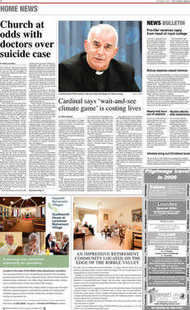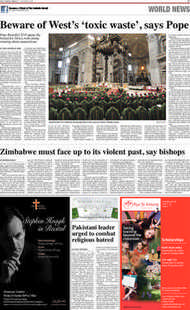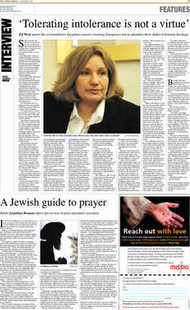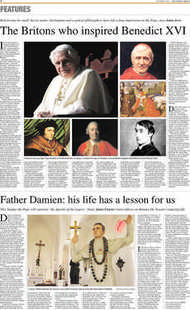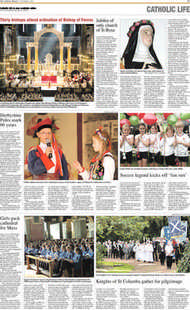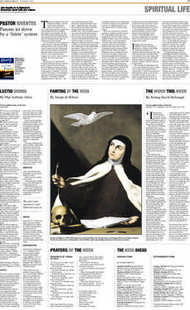Page 16, 9th October 2009
Page 16
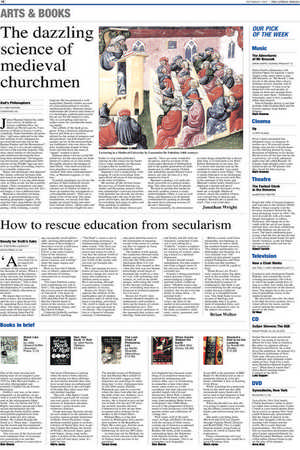
Report an error
Noticed an error on this page?If you've noticed an error in this article please click here to report it.
Tags
Share
Related articles
Our Schools Can Forge A New Christian Civilisation
Darwinism And The Faith
Spiritual Books Francis Phillips
How To Love Our Muslim Neighbours
Ushering In Another Second Spring
How to rescue education from secularism
Beauty for Truth’s Sake
BY STRATFORD CALDECOTT BRAZO PRESS, £12.99
‘Amerely subjective creativity is no match for the vast compass of the cosmos and for the message of beauty. When a man conforms to the measure of the universe, his freedom is not diminished but expanded to a new horizon.” That is how Stratford Caldecott sums up the importance of a traditional, holistic Catholic education in his book.
He argues that we have done science, the humanities, and the arts a great disservice by separating them from each other. The truth is one, so we must unite all that lead to the truth. Echoing John Paul II, Caldecott asserts that theol ogy can greatly enrich philosophy, pointing philosophy and other areas of knowledge in directions it never would have gone. Because the Logos, Christ, is the main creative force of the universe, “Liturgy, mathematics, art, music, science, and worship” share the same origins and basic nature.
Here we have the Catholic view of liberty, opposed to the carte blanche of endless consumerism or sexual experiences.
This inner freedom comes from conforming our will to God’s. The argument follows the ressourcement movement of Vatican II. This point of view, taken also by Benedict XVI and John Paul II, argues that the Church needs to return to the sources, to the New Testament, liturgy, and the Church Fathers.
Caldecott faithfully outlines Benedict XVI’s teaching: “The Pope’s vision is one in which human existence is fundamentally liturgical”. In other words: “Our lives can be oriented toward God by prayer and action in such a way that the interior world of the human soul and the exterior world of the society and universe are brought into harmony.” He is not arguing for revolution, at least not the kind of dramatic change for which so many anti-capitalists or nihilists seem to argue. He is advocating, through ressourcement, a harmony and stability in society.
Beauty for Truth’s Sake opposes the nihilism of the marketplace and of modern education, both of which fragment everything, and where “the world is made up of bits we can use and consume as we choose. This fragmentation is a denial of ultimate meaning. Contemporary education therefore tends to the elimination of meaning – except in the sense of a meaning that we impose by force upon the world.” The modern world ignores the connection between truth, beauty, and goodness. Caldecott cites the 20th-century theologian Hans Urs von Balthasar, who warned us that when this link was lost human knowledge would begin to dominate the world in a sinister way, with technology and science, as well as the profit margin, suffocating the world. In this fiercely utilitarian view, everything must have a financial or technical purpose for it to exist.
Beauty for Truth’s Sake contains detailed chapters on mathematics and numbers, showing the beauty of certain mathematical laws. This discussion gives substance to the argument that science and theology, faith and reason, and beauty and the truth are intimately connected. Caldecott is not calling for a “Catholic” science to replace the science we have, but for a re-visioning of science, opening science to a spiritual dimension.
Science should remain independent, but take inspiration from a bigger sense of the universe than the one it currently has.
Science’s strong materialist stance prevents it from acknowledging a higher or spiritual reality. Caldecott notes: “Modern science has discovered many more natural wonders, but we have lost the ability to relate these ... to spiritual truth.” Interestingly, the author writes, the basis to the medieval educational system, the quadrivium, consisted of the study of numbers: arithmetic, music, geometry, and astronomy. Before a monk could learn philosophy and theology in the trivium, he had to study the numbers-based universe. This linked mathematics to philosophy and theology in a very intimate way. The medieval educational system echoed Pythagoras and Plato in believing that numbers themselves could be a path to God.
While Beauty for Truth’s Sake contains many big ideas, such as the numbers wisdom of the Trinity, or the mystical and theological aspects of mathematics, the book is not overwhelming for the average reader because Caldecott writes in a straightforward way. This book helps to cover an area of theology and philosophy that is in great need of expanded ideas, and that is an alternative view to the atheist movement.
Brian Welter
blog comments powered by Disqus



